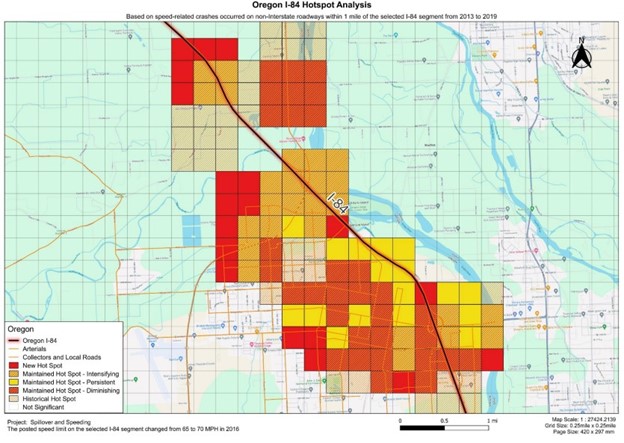BOISE – It’s called the “spillover effect” – raising speed limits on freeways can increase the number of speed-related crashes on nearby roads. And according to new research by the AAA Foundation for Traffic Safety, the dangers are all too real.
AAA recently studied the effects of faster speed limits – before and after they were implemented – on stretches of interstate highways in Oregon, Michigan, and Georgia. When researchers evaluated local roads within a 1-mile radius of the interstate, they found dangerous clusters of crashes, or “hotspots,” that appeared, changed locations, or intensified in combination with a faster freeway.
That’s a concern, because according to the National Highway Traffic Safety Administration, speeding is a contributing factor in nearly one-third of all fatal crashes nationwide. And the Idaho Transportation Department reported that in 2022, 51% of motor vehicle crashes in the Gem State involved an aggressive driver.
“As people acclimate to faster speeds, some may be tempted to continue ‘making good time’ when they leave the highway,” says AAA Idaho public affairs director Matthew Conde. “Faster speeds that may be appropriate on limited-access roads are not suitable for roads that are being shared with children, bicyclists, and pedestrians.”
In keeping with the Safe System approach, AAA urges a holistic strategy in transportation planning, including the use of technology and collaboration between stakeholders, to quickly identify and address safety concerns.
“Like any chiropractor will tell you, when one thing is out of alignment, it can have a chain reaction across the entire system. Computer models and thoughtful communication are important aspects of traffic safety,” Conde said. “Many transportation officials are also moving away from the 85th percentile (the speed at which 85% of traffic is moving) in favor of a more comprehensive approach to setting speed limits.”
To reduce the number of speeding-related crashes, AAA recommends:
- Public awareness campaigns, with special focus on reaching the riskiest drivers (including younger males)
- Road design elements that calm traffic on surface streets, including curb extensions, speed dips, and narrower lanes where appropriate
- Increased understanding of crash impacts and stopping distances at higher speeds
For the study, the AAA Foundation analyzed a section of I-84 in Oregon that runs from Wasco County along the Columbia Gorge through Ontario and Malheur County. The speed-related hotspots for Malheur County are noted below, including new, diminished, and intensified trouble spots:

“The map shows the challenge we face – while some problem areas were reduced when the speed limit increased, some existing situations got worse and some new issues emerged,” Conde said. “When you’re driving around town, please remember that you’re near schools and residential neighborhoods, and reduce your speed. We all need to do our part to keep our communities safe.”

